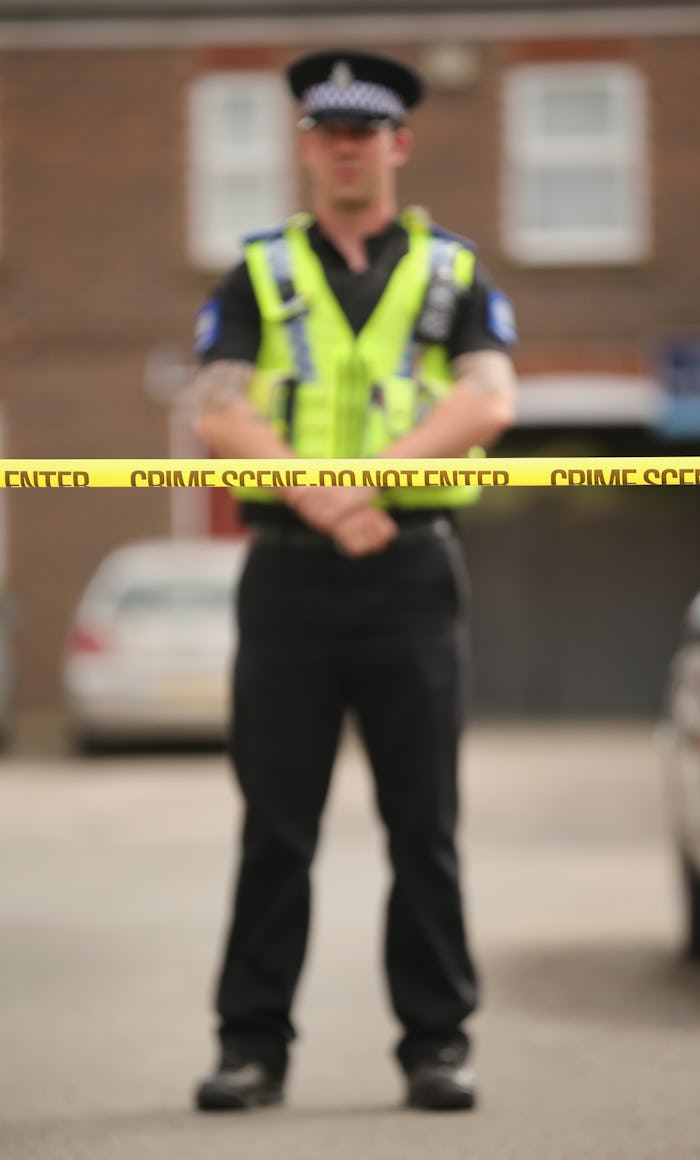News

This Photo From North Park Elementary Is Chilling
On Monday afternoon terrifying news broke that four people had been shot at North Park Elementary School in San Bernardino, California, according to The Hill. Once the situation was under control the San Bernardino police chief tweeted that two people had died and two students had been hospitalized in an apparent murder-suicide, according to a tweet from The Associated Press. As usual, tweets calling for "prayers for North Park" or "prayers for San Bernardino" came rolling in, but one chilling photo of children holding hands as they leave the elementary school shows that, yet again, a school shooting has happened, and yet again, Americans and lawmakers are going to pretend that there's nothing they could've done to stop it, all while the lives of more children have been threatened, and the lives of even more will continue to be.
Val Gratias, an executive producer for KTLA5 Morning News tweeted a photo of children evacuating the North Park Elementary School on Monday afternoon. The children were walking in a line and holding each other's hands. The line was surrounded on either end and on the sides by police officers in bulletproof vests. The shot looks innocent if you glance at it for a moment, but in context, it is anything but that.
The shooting at North Park on Monday marked the 200th school shooting since 2013, according to an email statement from Lizzie Ulmer at Everytown for Gun Safety. The shooting was also the 12th school shooting of 2017, according to Ulmer.
Let's cut straight to the chase: the common argument on Twitter regarding the North Park shooting is that schools, which are gun-free zones, would be more safe if they weren't gun free, because then a shooter like the one who reportedly killed him or herself after killing someone else wouldn't have been able to commit the crime. Aside from the fact that that just isn't historically, statistically, or factually true or possible (the argument would also presume that teachers are all trained in how to use a firearm, have their firearms ready at all times, and that the kids know how to get out of the way of fire), the idea that schools should turn into violent battle zones when someone has a weapon is horrifying and flawed from the beginning.
As many people pointed out in response to the above photo on Twitter, shootings just don't result in the death or injury of people (children included), the violence of shootings leaves kids, adults, and others with long-term effects like post-traumatic stress disorder; anxiety; trouble sleeping, concentrating, or eating; or problems remembering simple things like tasks you need to complete, according to the American Psychological Association (which actually has a page on how to "manage your distress" in the aftermath of a shooting).
Arguments that say we should allow guns at schools to prevent other people with guns from killing seem to ignore an important fact: those schools are populated by children. The children will be severely affected or potentially killed regardless of whether their teacher could get to a weapon to try to stop a potential shooter. Children should be able to walk across the grass and hold hands with their classmates and friends, yes, but they shouldn't have to do that surrounded by police officers, because someone who shouldn't have a weapon somehow managed to get to one.
The above photo makes it clear that nothing prevents children from being children more than violence. And gun violence is the type of violence that kids are most likely to encounter as they grow up in the United States, simply because of the fact that it has touched so many people. Newtown Director Kim Snyder told me in an interview in the fall about her film — which was about Newtown, Connecticut's healing after the December 2012 shooting that left 20 children and 6 school administrators dead — that shootings affect more than just those they leave dead or injured. They affect the families of the dead or injured, those who saw the shooting, the first responders to the shooting, the clergy who might have to bury the dead, the doctors that are involved in the treatment and recovery of those surviving, the local news teams who cover the events in the months and years after — shootings affect thousands of people when they're all said and done.
If we know that our current methods when it comes to gun safety — not allowing the CDC to do any research on deaths from gun violence, not requiring universal background checks for all gun purchases, allowing those who have stalked or abused a partner to purchase weapons — means children and people will die, why aren't we willing to try something new? When our kids are holding hands to get away from their schools as quickly as possible, why is our solution to add more of what caused them to flee in the first place? When we finally decide to approach the issue of gun safety with something other than egos and the false notion that someone is going to "take away our guns," then maybe we can finally stop people's children from dying.